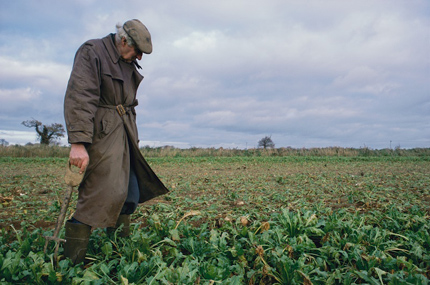
Norfolk, 2008
Situated on the east coast of Great Britain, East Anglia is one of the country’s chief agricultural regions. The flat landscape, massive skies and long farming heritage make East Anglia the closest place Britain has to a prairie.
For the last nine years I have been traveling the back roads of rural East Anglia, passing down drove and lane, track and way. On my journeys I discovered the remnants of an agrarian community that was once widespread throughout this area. For most people this is a world that no longer exists. It is where traditional methods and knowledge are still very much depended upon, and the identity of the people is intimately shaped by the land on which they live and work. Small-time farmers, reed cutters and rabbit catchers, these are the East Anglians — the forgotten people of the flatlands who continue to work the land because the need to is in their blood.
Central to an agrarian culture is the idea of land: not just working the land, living on the land and owning the land (all which are important) — but that much deeper concept of being part of the land; the process of it becoming both physically and psychologically ingrained in the human experience. It is impossible to escape the presence of the landscape. It creeps from the fields into the home. It enters through an open window, or a crack under the door; embedded in the palm of a hand, or on the sole of a boot. Leeks sprout from the curtains and the tabletop is fenland peat. The agrarian farmers I have come to know are so deeply rooted to the land, it is as if they grew out of the soil like a tree. Such an intimate relationship comes from what the rural writer, farmer and activist Wendell Berry, describes as "knowledge in place for a long time."
To enter into the agrarian world of the East Anglians is to experience a rural culture that has a direct lineage extending back to the region’s peasant farmers of the early Middle Ages. The agrarian farmer always has one foot firmly planted in the past. The old ways are proven to work and can therefore be relied upon. Everything is visibly ingrained with history. Buildings are often cobbled together and are a ramshackle mix of wood, tin and stone. And the agricultural machinery is a patchwork of rust, mud and oil stains in which the past is embedded.
The agrarian farmer knows in fine detail the histories and biographies of his local landscape. After years of familiarity with the land he knows what is the best cycle of crop rotation on any particular field, where it lies wet in winter and how best to plow, sow, hoe and harvest that field to reap the best from it. Unaided by any map, he can negotiate the complex network of local droves and tracks by day and night, and walk the fields and woodlands, fen and marsh with equal agility. Inside the agrarian mind are the local wind patterns and river currents; along with the life stories of the local inhabitants, wildlife habitats and tree and plant species past and present. I have been told of farmers who have come and gone, from what direction the fox will come to steal a chicken and who planted a particular oak tree and when.
But during the last 60 years an agrarian way of life has become increasingly irrelevant in a modern society, and the East Anglians find themselves living on the margins. Most of the small family farms are now gone, while the fields of agribusiness have grown bigger, swallowing up the landscape as they go. The result is the depopulation of the rural landscape, and with it the loss of the knowledge of local place and the traditional skills of working the land that are so important to an agrarian culture. As one old-time farmer said to me, "It’s just one big tractor now and a thousand acres. There’s nobody on the land today. But," he continued, "there will always be those that straggle on — the awkward ones who remain."
I have spent many hours in the fields, patiently watching how man and the landscape intimately shape one another. If I look closely, occasionally I am offered a glimpse into the mystery of this ancient relationship. It is a fleeting moment; I click the shutter, and I wait…. — Justin Partyka
Justin Partyka is a British photographer and writer currently based in the county of Norfolk. He trained as a folklorist at Memorial University, Newfoundland, Canada, before moving back to the UK to work on The East Anglians.
The East Anglians will be exhibited at the Sainsbury Centre for Visual Arts, Norwich, UK, through December 13, 2009.
